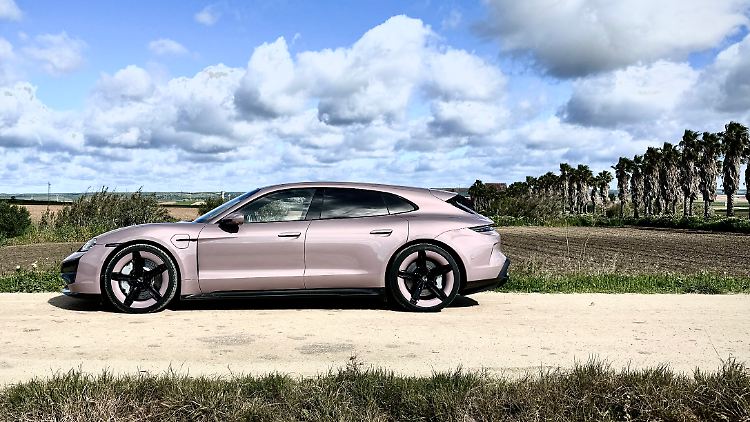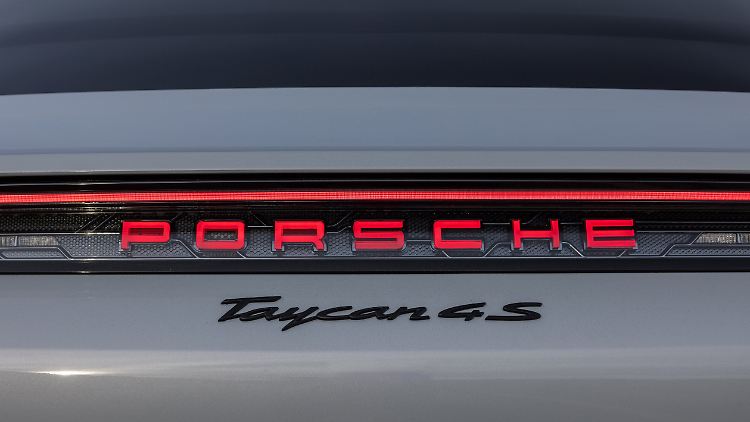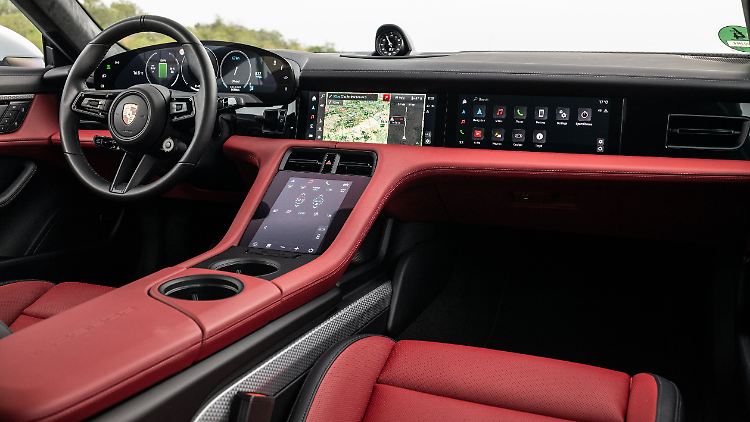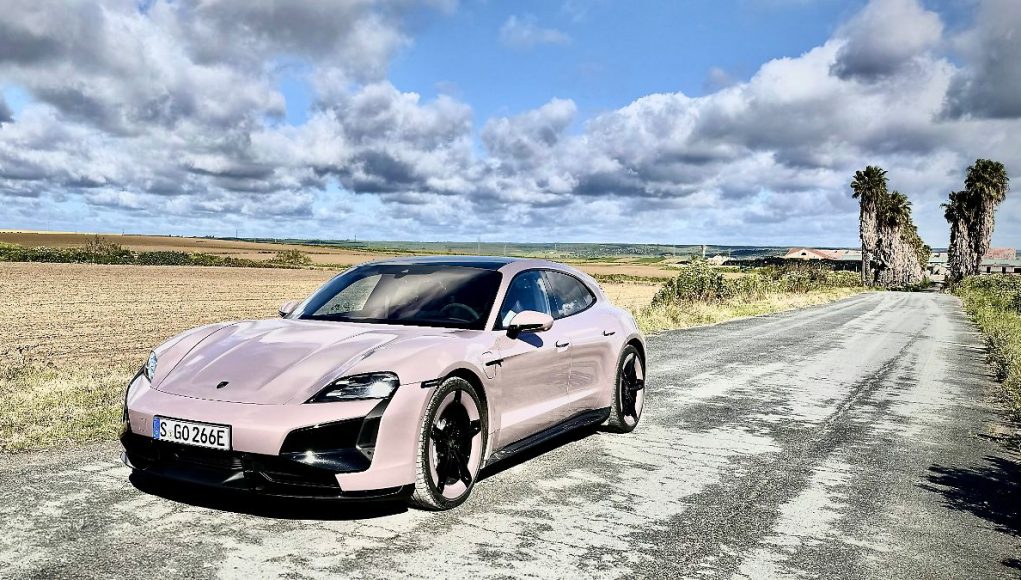The modified Porsche Taycan shines above all in secret under the sheet metal: with a drastically revised chassis, enormously increased charging performance and optimized range. ntv.de was now able to drive it.
Porsche cleverly gets the guests' mouths watering with a dynamic ride to the charging station. As a reminder: At the beginning of this year, the Zuffenhausen-based developer had loaded from 37 to 50 percent within 172 seconds as a disguised developer. I was a witness. And now I can get started myself behind the wheel of the modified model, which experts call the “J1 II”.


From the side perspective, the body-colored rims stand out. Not for people who want to reach their destination inconspicuously.
(Photo: Patrick Broich)
To be honest, you can accept the slight visual differences or not. A completely different, actually banal thing is more important when you consider that the Taycan is supposed to be a noble express travel tool with high-tech standards. The rear-wheel-drive basic model used to be touted as having a range of 503 kilometers. Now it's 678 kilometers! Rums! And the top model Turbo S? Increased from a meager, travel-unfriendly 467 kilometers to a whopping 630 kilometers.
How can something like this work? By making the engine significantly more efficient and increasing the battery capacity. And by the way, the battery weight has fallen by around nine kilograms with an increase of almost 12 kWh. The average WLTP electricity consumption fell from around 20 to 16 kWh per 100 kilometers. The reduction in consumption is even more drastic in the all-wheel-drive top model Turbo S – six kWh are saved per 100 kilometers (from 24 to around 18). And then the loading speed has also increased, but that will be a topic later.


The Turbo Sport Turismo in “Frozenberry Metallic” may be a bit over-the-top in terms of paint color – but it's guaranteed to be an eye-catcher.
(Photo: Patrick Broich)
Now we're finally driving, with the base. It is now 435 hp (instead of 408) if the so-called “Performance Battery Plus” is ordered. In this case, their gross energy content also increases from 89 to 105 kWh. And of course, the test car fleet is always blessed with large power storage. It's just too bad that at the end of the planned route with the basic model, the turbo variants also tempt you with test drives. Since I can imagine that they accelerate much more violently, I have to let it melt in my mouth now. Will I get movement in the rear given the power on the rear axle? Difficult, the 275cc Michelins at the rear transmit the 420 Newton meters of maximum torque without any problems. Wait a minute, no. Porsche, as a technology company, of course knows more precisely: the wheel torque with Launchcontrol is even 6530 Newton meters. It's somehow a difficult value to imagine, but whatever. The Taycan, which weighs around 2.1 tons, zooms you to 100 km/h within 4.5 seconds and reaches speeds of up to 230 km/h, which would cause a conflict with the law here in Spain. You don't need more punch, for sure.
When it comes to the chassis, the Taycan now delivers more high-tech than before


Since illuminated lettering is in vogue, the Porsche Taycan of the new model year will also have one.
(Photo: Porsche)
But because having is better than needing, I want more and am also trying out the turbo models. Logical, after all they are ready for a test drive. And what happens when you change vehicles? The Turbo S Sport Turismo that had just driven up (still available here, no longer available on the Panamera) greets me with the body shooting up when I open the door. The optional high-tech chassis with one pump element per wheel can now. So that I can get started better. What a performance. That's funny, but nothing compared to the current maximum output of 952 hp. What happens here at full load can no longer be described as it used to be. Press properly into the seat. Push hard. Fire away. All well and good. But somehow also a stupid platitude.
I'll put it another way. I drank a glass of orange juice before setting off. Now I do a launch start with the Turbo S. The 2.3-ton truck starts to move and with a tiny delay I feel the liquid splashing against the wall of my stomach. Just like a bottle lying on the floor flies backwards when accelerating and hits the seat. According to the factory, the 4.96 meter liner can reach 100 km/h in 2.4 seconds, while at 260 things it stops. You can now play the game up to the 598 hp 4S with a large battery. The Turbo (884 hp and therefore more powerful than the previous Turbo S with 761 hp) packs a similarly brutal punch, reaching 100 km/h in 2.7 seconds, while the 4S (3.7 seconds to 100 km/h) does noticeably more relaxed. So “more relaxed”.


Display as far as the eye can see. The front passenger can also happily tumble around in the Taycan. But it costs around 1360 euros extra.
(Photo: Porsche)
But is there anything else that has improved with the facelift other than increased efficiency and excessive performance? Already. I keep squinting at the left segment of the instrument cluster (of course it appears in the form of a curved display). The battery charge level and the current temperature of the battery can be read there. But the number to the left of the battery temperature is exciting. The Taycan shows here how many kilowatts of maximum charging power would be possible on the car side. In this way, Porsche is making the charging performance more transparent. Because if an electrically powered car is slower at the charging station than the technical information suggests, it causes frustration for the driver. Well, if the network is no longer available or the column is lame, a perfectly good Taycan battery is of course of little use. But then you at least know that it's not the car.
The refreshed Taycan is said to be a loading monster
But now Tacheles, how does the Taycan charge? Or rather – how does Porsche promise that its top electric car should charge? It used to take 21.5 minutes for the battery to reach 80 percent again starting from 10, but today it only takes 18 minutes. And 80 percent state of charge today means, as we learned at the beginning, a lot more kilometers than before.
By the way, the Taycan should not only maintain its 320 kW charging power peak (with the small battery 270 kW) longer than before (generally 270 kW), but it also initializes faster. Charging should start after 32 instead of 49 seconds. However, ntv.de will have to carry out investigative work in the next few months to confirm whether the factory information is at least approximately correct.
Oh yes, and there is one more little thing. Porsche still has the 1108 hp (yes, you read that right) strong Turbo GT up its sleeve. This means that the Zuffenhausen-based company is breaking the 300 km/h sound barrier electrically for the first time. Because until now it was over at 260 things. And the top model is supposed to set standards in various disciplines. But please be patient for a few more days.
In the meantime, the configurator invites you to have fun playing. The prices of the respective basic models range between an expensive 101,500 euros and a very expensive 209,900 euros for the Turbo S. And there are many options to choose from. The spacious, comfortable travel electric car is not a bargain. Not even with air suspension as standard. But you wouldn't have expected anything else from Porsche, would you?
































